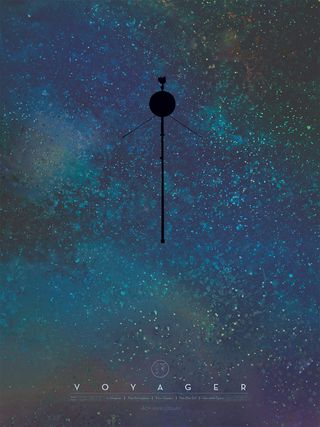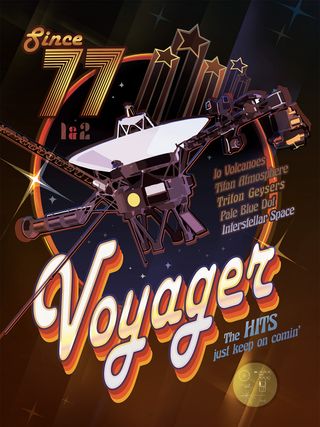Celebrate Voyager Probes' 40th Anniversary with Scientist Stories, Free Posters
On Tuesday (Sept. 5) marks 40 years since the launch of the Voyager probes and the start of one of NASA's most ambitious programs to date, and the agency's Jet Propulsion Laboratory (JPL) wants to share this extraordinary milestone with the public by offering two wonderful online resources.
The Voyager 1 and 2 spacecraft launched two weeks apart, on Aug. 20 and Sept. 5, 1977, on a mission to study the planets and, eventually, the edge of the solar system. Voyager 2 launched first, although the faster-moving Voyager 1 is now farther away from Earth than its sister-probe, and reached interstellar space in 2013. Voyager 2 is currently flying through the bubble of solar material that marks the boundary between the solar system and interstellar space.
You can bring the Voyager mission into your home by downloading and printing NASA's free Voyager posters. The posters are part of a series created by a team of visual strategists at JPL known as "The Studio." One of the Voyager posters is an image of a starry night sky, and another advertises the mission using the flamboyant design style of the 1970s, the decade when the probes launched. A third poster honors the probes' "grand tour" of the planets, on their way to the edge of the solar system.

In addition, members of the public can get an inside look at the Voyager mission from some of the scientists, engineers and other contributors to the mission over its more than 40-year history. JPL officials asked members of the Voyager team to write about their "most memorable Voyager moment," and posted them to the JPL website. The stories include reflections from people who were there when the mission began and people who joined when Voyager 1 was already nearly outside our solar system.
"For me, the highlights of Voyager were clearly the planetary encounters," wrote Ed Stone, a Voyager project scientist who has been with the mission since its inception. "All six of them were wonderful experiences where every day we saw and learned new things. We had a lifetime of discovery packed into each one.

"The eruptions on [Jupiter's moon] Io were the first direct evidence of active volcanoes elsewhere in the solar system," he continued. "Even though Io is much smaller than Earth, it had ten times as much volcanic activity. This astonishing discovery clearly signaled that we could expect many more surprises. And Voyager has certainly revealed a remarkable diversity of planets and their moons, rings and magnetic fields that has changed our view of the solar system."
Linda Spilker, who now serves at chief scientist for the Cassini mission at Saturn, wrote that her position with the Voyager mission was her first job out of college.
Get the Space.com Newsletter
Breaking space news, the latest updates on rocket launches, skywatching events and more!
"I was the Infrared Interferometer Spectrometer and Radiometer (IRIS) experiment representative, the interface between the Voyager project and the IRIS scientists at Goddard [Space Flight Center in Maryland]," Spilker said. "I was the only woman in their group and very proud to represent them. What a thrill to work with such an incredible group of talented scientists. They mentored me and later invited me to join them as part of the Cassini infrared team."
There are more stories and more posters on the JPL website.
Follow Calla Cofield @callacofield. Follow us @Spacedotcom, Facebook and Google+. Original article on Space.com.
Join our Space Forums to keep talking space on the latest missions, night sky and more! And if you have a news tip, correction or comment, let us know at: community@space.com.

Calla Cofield joined Space.com's crew in October 2014. She enjoys writing about black holes, exploding stars, ripples in space-time, science in comic books, and all the mysteries of the cosmos. Prior to joining Space.com Calla worked as a freelance writer, with her work appearing in APS News, Symmetry magazine, Scientific American, Nature News, Physics World, and others. From 2010 to 2014 she was a producer for The Physics Central Podcast. Previously, Calla worked at the American Museum of Natural History in New York City (hands down the best office building ever) and SLAC National Accelerator Laboratory in California. Calla studied physics at the University of Massachusetts, Amherst and is originally from Sandy, Utah. In 2018, Calla left Space.com to join NASA's Jet Propulsion Laboratory media team where she oversees astronomy, physics, exoplanets and the Cold Atom Lab mission. She has been underground at three of the largest particle accelerators in the world and would really like to know what the heck dark matter is. Contact Calla via: E-Mail – Twitter
